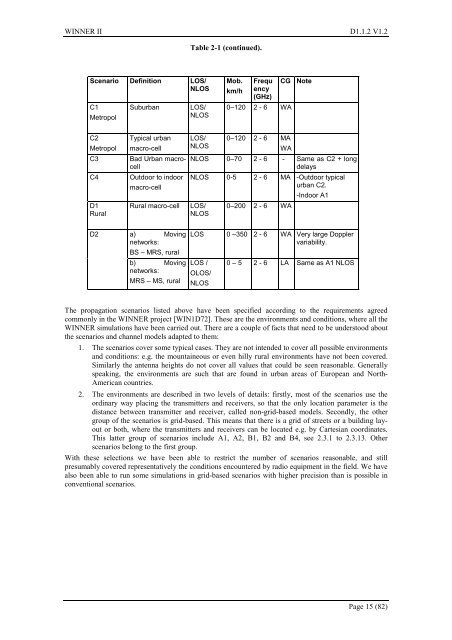WINNER II pdf - Final Report - Cept
WINNER II pdf - Final Report - Cept
WINNER II pdf - Final Report - Cept
Create successful ePaper yourself
Turn your PDF publications into a flip-book with our unique Google optimized e-Paper software.
<strong>WINNER</strong> <strong>II</strong> D1.1.2 V1.2<br />
Table 2-1 (continued).<br />
Scenario Definition LOS/<br />
NLOS<br />
C1<br />
Metropol<br />
Suburban<br />
LOS/<br />
NLOS<br />
Mob.<br />
km/h<br />
Frequ<br />
ency<br />
(GHz)<br />
0–120 2 - 6 WA<br />
CG Note<br />
C2<br />
Metropol<br />
C3<br />
C4<br />
D1<br />
Rural<br />
Typical urban<br />
macro-cell<br />
Bad Urban macrocell<br />
Outdoor to indoor<br />
macro-cell<br />
Rural macro-cell<br />
LOS/<br />
NLOS<br />
0–120 2 - 6 MA<br />
WA<br />
NLOS 0–70 2 - 6 - Same as C2 + long<br />
delays<br />
NLOS 0-5 2 - 6 MA -Outdoor typical<br />
urban C2.<br />
LOS/<br />
NLOS<br />
0–200 2 - 6 WA<br />
-Indoor A1<br />
D2<br />
a) Moving<br />
networks:<br />
BS – MRS, rural<br />
b) Moving<br />
networks:<br />
MRS – MS, rural<br />
LOS 0 –350 2 - 6 WA Very large Doppler<br />
variability.<br />
LOS /<br />
OLOS/<br />
NLOS<br />
0 – 5 2 - 6 LA Same as A1 NLOS<br />
The propagation scenarios listed above have been specified according to the requirements agreed<br />
commonly in the <strong>WINNER</strong> project [WIN1D72]. These are the environments and conditions, where all the<br />
<strong>WINNER</strong> simulations have been carried out. There are a couple of facts that need to be understood about<br />
the scenarios and channel models adapted to them:<br />
1. The scenarios cover some typical cases. They are not intended to cover all possible environments<br />
and conditions: e.g. the mountaineous or even hilly rural environments have not been covered.<br />
Similarly the antenna heights do not cover all values that could be seen reasonable. Generally<br />
speaking, the environments are such that are found in urban areas of European and North-<br />
American countries.<br />
2. The environments are described in two levels of details: firstly, most of the scenarios use the<br />
ordinary way placing the transmitters and receivers, so that the only location parameter is the<br />
distance between transmitter and receiver, called non-grid-based models. Secondly, the other<br />
group of the scenarios is grid-based. This means that there is a grid of streets or a building layout<br />
or both, where the transmitters and receivers can be located e.g. by Cartesian coordinates.<br />
This latter group of scenarios include A1, A2, B1, B2 and B4, see 2.3.1 to 2.3.13. Other<br />
scenarios belong to the first group.<br />
With these selections we have been able to restrict the number of scenarios reasonable, and still<br />
presumably covered representatively the conditions encountered by radio equipment in the field. We have<br />
also been able to run some simulations in grid-based scenarios with higher precision than is possible in<br />
conventional scenarios.<br />
Page 15 (82)
















